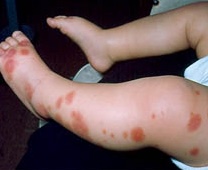Henoch-Schonlein Purpura in children is a non-contagious rash from the inflammation of small blood vessels. Very few children experience complications with this diagnosis, but physicians may prescribe steroids if there are further complications. Dr. Bornstein will discuss practical insights into understanding the signs, symptoms, and treatment of Henoch-Schonlein Purpura.

HENOCH-SCHONLEIN PURPURA DEFINITION:
Inflammation of small blood vessels which causes a characteristic rash. It is also known as anaphylactoid purpura or non-thrombocytopenic purpura.
SYMPTOMS OF HENOCH-SCHONLEIN PURPURA:
- Rash
- Red, bruise-like rash occurring on the legs, buttocks and back. This may be associated with fever and malaise.
CAUSES:
The cause is unknown, but physicians think it may be a virus manifestation.
CONTAGION:
This rash is not contagious.
DIAGNOSIS:
A physician will diagnose Henoch-Schonlein Purpura based on symptoms and rash characteristics. Lab tests have shown a decrease in platelets—sometimes associated with anemia—and an increased sed rate, which is a sign of inflammation.
OUTCOME:
The outcome for Henoch-Schonlein Purpura is excellent in almost all cases. Very few children experience complications, which may include kidney and intestinal problems.
TREATMENT AND DISCUSSION:
Henoch-Schonlein Purpura has a very characteristic rash. The rash usually occurs on the lower part of the body and starts as light red spots that darken over time and fade over two weeks. This rash forms what are called petechiae, or purpura. These are very dark red pinpoint spots (for petechiae) or larger red spots (for purpura) that do not disappear when the skin is pulled taut on either side of the rash (they do not blanch).
The diagnosis is most common in children between two and eight years old. Complications include damage to the small blood vessels in the kidney and intestine. This damage can cause disease in these organs; however, these complications are very rare. Physicians have prescribed steroids, in some cases, with some success. Usually, time is all that is needed for the illness to pass.
ONE DOCTOR’S OPINION ABOUT HENOCH-SCHONLEIN PURPURA:
Henoch-Schonlein Purpura is generally a self-limited illness. The big question for me is whether or not I should treat with steroids. Different physicians will have different opinions on this. If there is blood in the urine or stool, then I begin considering potential complications. At this point, I choose to use steroids. Kidney disease will usually resolve with the start of steroids. Intestinal disease can resolve with steroids, but sometimes surgery or a barium enema is necessary to correct an obstruction or intussusception.
Intussusception is when a part of the intestine folds into another part (like a telescope being closed), which cuts off the blood supply to the affected area. A barium enema can put pressure against the inside of the intestinal wall and pop it open. These complications are very rare, but it is always important to be sure that there is no blood in the urine or stool with a diagnosis of Henoch-Schonlein Purpura.
This blog was written by Dr. Michael Bornstein, who has 30 years of experience as a pediatrician.
Disclaimer: The contents of this article, including text and images, are for informational purposes only and do not constitute a medical service. Please note that all images belong to their original owners. Always seek the advice of a physician or other qualified health professional for medical advice, diagnosis, and treatment.


FOLLOW US